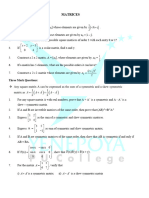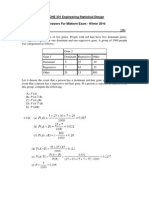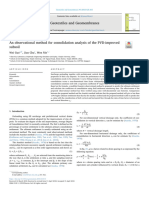Math2081 2010C Midterm Sol
Uploaded by
Triet NguyenMath2081 2010C Midterm Sol
Uploaded by
Triet Nguyen1
MATHEMATICS FOR
COMPUTING SCIENCE
MID-SEMESTER TEST
Exam Date: 25
th
November 2010
Reading Time: 9:00 am 9:10 am
Writing Time: 9:10 am 10:10 am
Examination Room: 1.4.20
Name:
ID No:
Group:
RULES
1. Calculators must not be taken into the examination room.
2. There are 6 questions. You must answer only 5 of them. Total mark is 100. Each
question is worth 20 marks. Please write at the bottom of this page which question
you choose not to answer.
3. Show all your work to get full marks. Even if your answer is incorrect, you might
get partial credit for the right way of reasoning.
4. This examination contributes 20% to the total assessment of Math 2081 course.
1. There are total 8 pages (including cover) in this booklet.
THE QUESTION THAT I CHOOSE NOT TO ANSWER IS:
2
Question 1: (10 + 10 Marks)
a) Let A = {x e N | 0 < 2x < 5} and B = {x e Z | |x| < 4} be sets.
Compute A, B, A \ B, A B, A B
b) Prove the following: Let A, B be sets. Then
(This is one of DeMorgans
laws. Prove it; do not just write follows from lecture.)
a) A = {1, 2}, B = { -3, -2, -1, 0, 1, 2, 3}, A \ B = C, A B = A, A B = B (2 Marks each)
b) To show = we show both _ and _.
_: Let
.
Case 1: x e A x e B since x e A B x e
by definition x e
for any set
.
Case 2: x e B is symmetric.
Case 3: x e A or x e B x e
or x e
by definition x e
.
Since there are no more cases, we are done.
_: Let x e
.
Case 1: x e
, since A B _ A and hence
Case 2: x e
, since A B _ A and hence
There are no more cases and hence we are done.
From both _ and _ we get the claim.
(10 Marks. There are many ways to prove this. Partial marks will be awarded.)
3
Question 2: (10 + 10 Marks)
a) Let = { (x, y) | x = y; x, y e N}. Is reflexive/symmetric/transitive? Is an equivalence
relation? Prove your claims.
b) Give an example of a relation that is not reflexive, not symmetric, and transitive. Prove your
claims.
a) This relation is not reflexive, since, for example, (1, 1) is not in . It is symmetric, since if x = y,
then y = x. It is not transitive, since (4, 5) e and (5, 4) e , but (4, 4) e . Since the relation is
neither reflexive nor transitive, it is no equivalence relation. (3+3+3+1 Marks)
b) For example define = {(x, y) | x > y; x, y e N}. Since never x > x, is not reflexive. Also is
not symmetric, since 5 > 4 but not 4 > 5. Finally, is transitive, since if a > b and b > c, then
obviously a > c. (4 Def + 2 + 2 + 2 Marks)
4
Question 3: (10 + 10 Marks)
Let f : R
+
(2, ) be defined by f(x) = x
2
2.
a) Is f one-one, onto, bijective? Prove your claims.
b) Compute the inverse function of f. Prove your claims.
a) f is one-one: Let x = y. Then x
2
= y
2
, sine x > 0 and y > 0. Then x2 2 = y2 2, and therefore f(x)
= f(y). Hence f is one-one. Furthermore, f is onto: let any y e (-2, ) be given. Then let x
= . Then f(x) =
Since f is one-one and onto, f is
bijective. (4 + 4 + 2 Marks)
b) Basically, we have done that already in the first part. Define f
-1
: (-2, ) R
+
by
. Then f is total on domain f, since x + 2 > 0 and therefore f
-1
(x) is defined. We have to
show f
-1
(f(x)) = x for all x e domain f. So let x e domain f be given. Then f
-1
(f(x)) = f
-1
(x
2
2) =
(5 marks for definition + 5 marks for proof)
5
Question 4: (6 + 6 + 8 Marks)
a) Express the following series with summation and/or product symbols. Do not compute the
results.
1. 1 + 4 + 9 + + 225 =
2. (2) * (2 + 4) * (2 + 4 + 6) * * (2 + 4 + 6 + + 20) =
3. 0 + 2 + 6 + 12 + 20 + + 380 =
(2+2+2 Marks)
b) Evaluate the following expressions; show your computation steps. (3+3 Marks)
1. 3x 2 = 6s3x-2s7 8sxs9 2/3sxs8
2. 3 - e( = 2<e<3-2>-e>-33-2>3-e>3-31>e>0, so 3 - e( = 1 (e = 2.7182)
c) Prove that x + y s x + y s x + y + 1 for all x, y e R.
Obviously 0 s | x x| < 1for all x. Let a = | x x| + | y y|. Hence 0 s a < 2. If 0 s a < 1, then
x + y = x + y, by definition of the floor function. If 1 s a < 2, then x + y = x + y +1,
again by definition of the floor function. Since there are no more cases, we are done. (8 Marks,
marks for partial solutions)
6
Question 5: (10 + 10 Marks)
a) A skateboarder goes down a half-pipe. Every time he goes up the other side half of what he
travelled down on this side. If the half-pipe is 40m long in total, how much distance will he cover,
if he just keeps rolling?
b) Prove the following: Let a
n
e R and b
n
e R for all n e N. If a
n
< b
n
for all n e N, and furthermore
then
a) He travels (20 + 10) + (10 + 5) + (5 + 2.5) + = 20 + 20 + 10 + 5 + = 20 + 20(1 + + + 1/8 +
) = 20 + 20 *
meters. (10 Marks; partial marks
awarded according to progress.)
b) Of course, A < B iff 0 < B A. Since we know a
n
< b
n
for all n e N, we can always find c
n
> 0, c
n
e R
such that b
n
= a
n
+ c
n
; (*). Hence we get:
So A < B iff 0 < B A iff 0 < C. But 0 < C is obvious, since all c
n
> 0 by assumption. So the claim is
proved. (10 Marks, partial marks awarded; other solutions are possible.)
First time
Second time
40m distance
etc
7
Question 6: (10 + 10 Marks)
a) Use the Gauss Jordan Algorithm to compute A
-1
for the matrix [
].
b) Let [
]. Compute M
2
and M
3
. What will M
n
look like for n > 3? Explain.
a) {
|
} {
|
} (Row 2 2 x Row 1) {
|
} (Row 2 divided
by -7) {
|
} (Row 1 5 x Row 2). So the inverse matrix is [
].
(9 marks for steps, 1 mark for making inverse explicit in some way.)
b)
[
],
[
]. From now on, all matrices M
n
will be completely zero.
(4 marks each matrix, 2 marks for conjecture.)
8
Extra sheet
You might also like
- Final MAT1141 1st CAT MARKING GUIDE 2024 Ac. YearNo ratings yetFinal MAT1141 1st CAT MARKING GUIDE 2024 Ac. Year9 pages
- Maths Class XII Chapter 01, 02 and 03 Revision Practice Paper 2024 AnswersNo ratings yetMaths Class XII Chapter 01, 02 and 03 Revision Practice Paper 2024 Answers7 pages
- 26 SACS11 SASE11 AACS11 AASE11 Discrete MathematicsNo ratings yet26 SACS11 SASE11 AACS11 AASE11 Discrete Mathematics6 pages
- Maths Class Xii Sample Paper Test 04 For Board Exam 2023 AnswersNo ratings yetMaths Class Xii Sample Paper Test 04 For Board Exam 2023 Answers18 pages
- Cbse+1 Mathematics Mid Term QP Ex - DT - 21!10!2024No ratings yetCbse+1 Mathematics Mid Term QP Ex - DT - 21!10!20245 pages
- Mll Study Materials Maths Class Ix 2024 25No ratings yetMll Study Materials Maths Class Ix 2024 2559 pages
- Maths Class Xii Sample Paper Test 09 for Board Exam 2025 QpNo ratings yetMaths Class Xii Sample Paper Test 09 for Board Exam 2025 Qp6 pages
- mathematics-extension-2-11-12-2024-hsc-sample-examination-materials copyNo ratings yetmathematics-extension-2-11-12-2024-hsc-sample-examination-materials copy56 pages
- Maths 2nd PUC Previous Year Questions (PYQ's)No ratings yetMaths 2nd PUC Previous Year Questions (PYQ's)28 pages
- Maths Class Xi Session Ending Exam Sample Paper 04 For 2019 20No ratings yetMaths Class Xi Session Ending Exam Sample Paper 04 For 2019 205 pages
- Maths Class Xii Sample Paper Test 07 For Board Exam 2024 AnswersNo ratings yetMaths Class Xii Sample Paper Test 07 For Board Exam 2024 Answers18 pages
- Relations and Functions: Smt. Pushpa Shamanur Mahalingappa Independent P.U. Science CollegeNo ratings yetRelations and Functions: Smt. Pushpa Shamanur Mahalingappa Independent P.U. Science College12 pages
- Maths Class Xii Chapter 01 to 08 Practice Paper 10 AnswersNo ratings yetMaths Class Xii Chapter 01 to 08 Practice Paper 10 Answers8 pages
- 1729056595224_12th_Half_Yearly_Math_2025_set_ANo ratings yet1729056595224_12th_Half_Yearly_Math_2025_set_A6 pages
- Plan for 70 - 80 Marks - Svpu(II Pu) - 2024 Final(Scoring Package)No ratings yetPlan for 70 - 80 Marks - Svpu(II Pu) - 2024 Final(Scoring Package)7 pages
- DMCA019: Discrete Mathematics: Section A Q1. Section ANo ratings yetDMCA019: Discrete Mathematics: Section A Q1. Section A4 pages
- Axiom: Course Title: Discrete MathematicsNo ratings yetAxiom: Course Title: Discrete Mathematics4 pages
- Trigonometric Ratios to Transformations (Trigonometry) Mathematics E-Book For Public ExamsFrom EverandTrigonometric Ratios to Transformations (Trigonometry) Mathematics E-Book For Public Exams5/5 (1)
- De Moiver's Theorem (Trigonometry) Mathematics Question BankFrom EverandDe Moiver's Theorem (Trigonometry) Mathematics Question BankNo ratings yet
- Further Consolidation Issues II: Accounting For Non-Controlling InterestsNo ratings yetFurther Consolidation Issues II: Accounting For Non-Controlling Interests31 pages
- Company Law - Lecture - Week 1 - Sem 2-2012No ratings yetCompany Law - Lecture - Week 1 - Sem 2-201237 pages
- Self Study Practice Questions Topic 3 Part 2 AnswersNo ratings yetSelf Study Practice Questions Topic 3 Part 2 Answers6 pages
- Source: Textbook, Craig Deegan Chapter 4 (Pages 169-172) : ACCT2159 Additional Exercises (PPE)No ratings yetSource: Textbook, Craig Deegan Chapter 4 (Pages 169-172) : ACCT2159 Additional Exercises (PPE)1 page
- Assignment Task1: Introduction ManagementNo ratings yetAssignment Task1: Introduction Management9 pages
- Good Will: J) Descried The Accounting Policies Relating To Intangible Asset Adopted by Worley ParksonsNo ratings yetGood Will: J) Descried The Accounting Policies Relating To Intangible Asset Adopted by Worley Parksons5 pages
- Fourier and Laplace Transforms: Indian Institute of Technology RoorkeeNo ratings yetFourier and Laplace Transforms: Indian Institute of Technology Roorkee13 pages
- ACRES 3255 - Session-5 - Research Methodology and Statistical ToolsNo ratings yetACRES 3255 - Session-5 - Research Methodology and Statistical Tools12 pages
- MANE 4240 & CIVL 4240 - Introduction To Finite Elements: Total Points: 40 Answer All QuestionsNo ratings yetMANE 4240 & CIVL 4240 - Introduction To Finite Elements: Total Points: 40 Answer All Questions1 page
- David S. Oderberg, P. F. Strawson - The Old New Logic - Essays On The Philosophy of Fred Sommers (Bradford Books) (2005)100% (1)David S. Oderberg, P. F. Strawson - The Old New Logic - Essays On The Philosophy of Fred Sommers (Bradford Books) (2005)255 pages
- CHE 331 Engineering Statistical Design Answers For Midterm Exam - Winter 2010 Question 1 (2-166)No ratings yetCHE 331 Engineering Statistical Design Answers For Midterm Exam - Winter 2010 Question 1 (2-166)5 pages
- An Observational Method For Consolidation Analysis of The PVD-improved SubsoilNo ratings yetAn Observational Method For Consolidation Analysis of The PVD-improved Subsoil9 pages
- Prelims - Chapter 2: Mathematics Language and SymbolsNo ratings yetPrelims - Chapter 2: Mathematics Language and Symbols30 pages
- Are Conversion, Selectivity and Yield Terms Unambiguously Defined in Chemical and Chemical Engineering Terminology?No ratings yetAre Conversion, Selectivity and Yield Terms Unambiguously Defined in Chemical and Chemical Engineering Terminology?10 pages
- Learner Guide For Cambridge IGCSE Physics 0972No ratings yetLearner Guide For Cambridge IGCSE Physics 097248 pages
- Tuning of Fuzzy Logic Controller Using Genetic Algorithm: Prepared byNo ratings yetTuning of Fuzzy Logic Controller Using Genetic Algorithm: Prepared by56 pages
- Advanced Thermodynamics: Exergy / AvailabilityNo ratings yetAdvanced Thermodynamics: Exergy / Availability64 pages
- Digital Image Watermarking Using D.W.T: By: Ashish Kumar (09407) Abhilasha Verma (09401No ratings yetDigital Image Watermarking Using D.W.T: By: Ashish Kumar (09407) Abhilasha Verma (0940117 pages
- GROUP 2 - Impact vs. Control Matrix and Affinity DiagramNo ratings yetGROUP 2 - Impact vs. Control Matrix and Affinity Diagram3 pages
- Paper - Contribution of LLR To Fundamental Astronomy - Chapront - 2001No ratings yetPaper - Contribution of LLR To Fundamental Astronomy - Chapront - 20016 pages
- Kinematics Is The Study of The Motion of An Object/body Without Considering The Cause ofNo ratings yetKinematics Is The Study of The Motion of An Object/body Without Considering The Cause of13 pages
- Maths Class XII Chapter 01, 02 and 03 Revision Practice Paper 2024 AnswersMaths Class XII Chapter 01, 02 and 03 Revision Practice Paper 2024 Answers
- 26 SACS11 SASE11 AACS11 AASE11 Discrete Mathematics26 SACS11 SASE11 AACS11 AASE11 Discrete Mathematics
- Maths Class Xii Sample Paper Test 04 For Board Exam 2023 AnswersMaths Class Xii Sample Paper Test 04 For Board Exam 2023 Answers
- Cbse+1 Mathematics Mid Term QP Ex - DT - 21!10!2024Cbse+1 Mathematics Mid Term QP Ex - DT - 21!10!2024
- Maths Class Xii Sample Paper Test 09 for Board Exam 2025 QpMaths Class Xii Sample Paper Test 09 for Board Exam 2025 Qp
- mathematics-extension-2-11-12-2024-hsc-sample-examination-materials copymathematics-extension-2-11-12-2024-hsc-sample-examination-materials copy
- Maths Class Xi Session Ending Exam Sample Paper 04 For 2019 20Maths Class Xi Session Ending Exam Sample Paper 04 For 2019 20
- Maths Class Xii Sample Paper Test 07 For Board Exam 2024 AnswersMaths Class Xii Sample Paper Test 07 For Board Exam 2024 Answers
- Relations and Functions: Smt. Pushpa Shamanur Mahalingappa Independent P.U. Science CollegeRelations and Functions: Smt. Pushpa Shamanur Mahalingappa Independent P.U. Science College
- Maths Class Xii Chapter 01 to 08 Practice Paper 10 AnswersMaths Class Xii Chapter 01 to 08 Practice Paper 10 Answers
- Plan for 70 - 80 Marks - Svpu(II Pu) - 2024 Final(Scoring Package)Plan for 70 - 80 Marks - Svpu(II Pu) - 2024 Final(Scoring Package)
- DMCA019: Discrete Mathematics: Section A Q1. Section ADMCA019: Discrete Mathematics: Section A Q1. Section A
- Trigonometric Ratios to Transformations (Trigonometry) Mathematics E-Book For Public ExamsFrom EverandTrigonometric Ratios to Transformations (Trigonometry) Mathematics E-Book For Public Exams
- De Moiver's Theorem (Trigonometry) Mathematics Question BankFrom EverandDe Moiver's Theorem (Trigonometry) Mathematics Question Bank
- Further Consolidation Issues II: Accounting For Non-Controlling InterestsFurther Consolidation Issues II: Accounting For Non-Controlling Interests
- Self Study Practice Questions Topic 3 Part 2 AnswersSelf Study Practice Questions Topic 3 Part 2 Answers
- Source: Textbook, Craig Deegan Chapter 4 (Pages 169-172) : ACCT2159 Additional Exercises (PPE)Source: Textbook, Craig Deegan Chapter 4 (Pages 169-172) : ACCT2159 Additional Exercises (PPE)
- Good Will: J) Descried The Accounting Policies Relating To Intangible Asset Adopted by Worley ParksonsGood Will: J) Descried The Accounting Policies Relating To Intangible Asset Adopted by Worley Parksons
- Fourier and Laplace Transforms: Indian Institute of Technology RoorkeeFourier and Laplace Transforms: Indian Institute of Technology Roorkee
- ACRES 3255 - Session-5 - Research Methodology and Statistical ToolsACRES 3255 - Session-5 - Research Methodology and Statistical Tools
- MANE 4240 & CIVL 4240 - Introduction To Finite Elements: Total Points: 40 Answer All QuestionsMANE 4240 & CIVL 4240 - Introduction To Finite Elements: Total Points: 40 Answer All Questions
- David S. Oderberg, P. F. Strawson - The Old New Logic - Essays On The Philosophy of Fred Sommers (Bradford Books) (2005)David S. Oderberg, P. F. Strawson - The Old New Logic - Essays On The Philosophy of Fred Sommers (Bradford Books) (2005)
- CHE 331 Engineering Statistical Design Answers For Midterm Exam - Winter 2010 Question 1 (2-166)CHE 331 Engineering Statistical Design Answers For Midterm Exam - Winter 2010 Question 1 (2-166)
- An Observational Method For Consolidation Analysis of The PVD-improved SubsoilAn Observational Method For Consolidation Analysis of The PVD-improved Subsoil
- Prelims - Chapter 2: Mathematics Language and SymbolsPrelims - Chapter 2: Mathematics Language and Symbols
- Are Conversion, Selectivity and Yield Terms Unambiguously Defined in Chemical and Chemical Engineering Terminology?Are Conversion, Selectivity and Yield Terms Unambiguously Defined in Chemical and Chemical Engineering Terminology?
- Tuning of Fuzzy Logic Controller Using Genetic Algorithm: Prepared byTuning of Fuzzy Logic Controller Using Genetic Algorithm: Prepared by
- Digital Image Watermarking Using D.W.T: By: Ashish Kumar (09407) Abhilasha Verma (09401Digital Image Watermarking Using D.W.T: By: Ashish Kumar (09407) Abhilasha Verma (09401
- GROUP 2 - Impact vs. Control Matrix and Affinity DiagramGROUP 2 - Impact vs. Control Matrix and Affinity Diagram
- Paper - Contribution of LLR To Fundamental Astronomy - Chapront - 2001Paper - Contribution of LLR To Fundamental Astronomy - Chapront - 2001
- Kinematics Is The Study of The Motion of An Object/body Without Considering The Cause ofKinematics Is The Study of The Motion of An Object/body Without Considering The Cause of







































































































